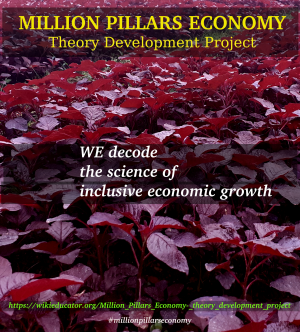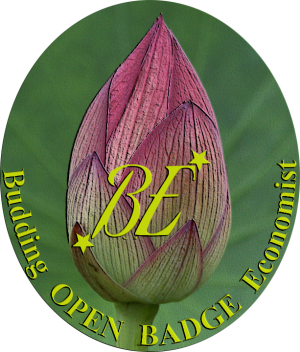Million Pillars Economy- theory development project
Warm welcome to Million Pillars Economy Theory Development Project
WE decode the science of inclusive economic development!!!
Project Home | Project Library | Budding Economist Badge | FAQ| Million Pillars Economy (Theory)
| Work in progress, expect frequent changes. Help and feedback is welcome. See discussion page. |
| Let us start with discussing things. Following the best practice on wikis, please visit the discussion page above and participate in discussions.You can either add your comments under an existing thread or create a new thread. Of course, you need a valid log-in for that. If you are new to WikiEducator, please request a log in by clicking the link for the same, which is there at the top of this page. Economics students and educators are encouraged to take the proposed principal theory on Million Pillars Economy or the Sub-theories to their classes for discussions, debates and seminars. We are definite that it will be challenging and interesting. We also hope that you will enjoy adding brief of such discussions back on the above discussion page. It will be a great contribution from you, which will take this theory development project forward for a better world. Budding Economist Badge Shall we introduce a badge for students who log on to Million Pillars Economy project page and write an article on the proposed principal theory or sub-theories? Article should be of minimum 750 words and added as a new discussion. We may name the badge as Budding Economist (BE). If agreed, wiki volunteers may come forward and design the badge. (Thank you Steve for designing an awesome project participant badge) A badge suggestion |
Contents
Million Pillars Economy : An economy that grooms each one of its entrepreneurs to build pillars of that economy with greater focus to small and medium industries, startups and farming so that economic growth would be wide spread and stable. It would be like the economy is pivoted strongly on million pillars. ICT enabled state-of-the-art supply chain management system, that is competent to facilitate transnational business, shall be the backbone of the Million Pillars Economy.
The theory of Million Pillars Economy is being discussed further.
In a Facebook discussion Steve Foerster proposed that Million Pillars Economy requires a decentralized political system. Jijoy Joseph, a Trainer and Entrepreneur from Kerala, suggested that there should be separate yardstick to assess the performance of pillars in a Million Pillars Economy. The factors like eco-friendliness, social orientation, the manner in which the acquired wealth goes back to the society etc should be considered.
In the Million Pillars Economy, in the demand supply side, each demand pillar will be connecting to its counterpart supply pillar directly. It has to be facilitated in a decentralized manner through a decentralized political system. Providing an enabling legal as well as technology framework would be the principal role of federal/central government.
Need for the New Theory
In majority of nations, the Economy is controlled by a few large corporates. As a result, their strategic failures at once influence the economy negatively. Whereas, Small and Medium Industries and Startups contribute to the economy in substantially high percentages and it seldom get due attention. If properly recognized, SMEs and Startups would be able to present the world with a more sustainably progressive economic order with the support of incomparably large numbers of creative, strategic and entrepreneurial leadership available. Hence the need for an alternative system driven by SMEs and Startups named as Million Pillars Economy.
Characteristics
- Democratic way of organizing an Economy: Million Pillars Economy is the democratic way of organizing economic activities by recognizing the responsibility and contributions of and offering due respect to each participant of the economy.
- Use of Progressive Technologies:: Progressive Technologies like Blockchain, Artificial Intelligence etc shall be used in the entire lifecycle of the business, which in turn would build and connect the pillars.
- Sustainably progressive:In the first place, entrepreneurship pillars will be kept on adding to the economy and the individual pillars will be growing as well. Secondly it is impossible to weaken a million pillars alike and all at a given point of time. It will also mean the worst effects of economic recessions will be eliminated for ever in a Million Pillars Economy.
- Resistant to Economic Downtimes:Economic downtimes are greatly felt when middle income and really poor, who form majority of the world population, are hit hard by the worst effects of recession. In a Million Pillars Economy, since there is always a better environment for application of alternative business strategies and the promotion of brand new alternative business befitting to economic situations, the downward segment of business cycle is likely to be blunted or affordable to the majority population. Therefore, technically, yes, the wave of business cycle with its ups and downs would be there, but its downtimes would be not hard hitting ones as we see now.
- Availability of capital and foreign trade are crucial to an economy. Both these can be effectively and sustainability strengthened in a Million Pillars Economy. If proper guidance is given large numbers of SMEs and Startups together would assimilate higher volumes of capital with in a shorter time than a few large establishments. Same would be the case of foreign trade.
- Social entrepreneurship: Million Pillars Economy can open up tremendous opportunities for social entrepreneurship development. It will also take care of environmental concerns.
- Demerger as a successful model: Merger is the rule of the day in all Economies. Demerger seldom happens, as it is not considered as a successful model. But in a Million Pillars Economy demerger would also be a successful model. Nothing will be lost completely in a Million Pillars Economy!
- Large business as an aggregator: Million Pillars Economy recognizes large business as an aggregator of SME and Startup business by way of outsourcing starting from cleaning of facilities to components manufacturing, from product designing consultancy to business processes reengineering consultancy and training, from market study to product distribution.
- Millions throttle development together: In a Million Pillars Economy development will be throttled properly by a million vibrant entrepreneurs.
- Lesser impact for lockouts and closures: In a Million Pillars Economy, the impact of lockouts and closures will be easily absorbed by continuing Pillars quite organically. In another words, opportunity cost of such decisions will me minimal.
- Lockdown Tolerance: Million Pillars Economy shall follow this: Lockdown Tolerance - A #covid19 lesson for organisation developers and system/performance auditors. Definition: Lockdown tolerance is the capacity of an organisation to withstand the impact of an unexpected lockdown. Framework of all organizations and businesses models including financial models should be developed giving due consideration to #lockdowntolerance Standard suggestion: Every system, whether commercial or noncommercial, public or private, should be developed with a minimum three months' tolerance to unexpected lockdowns.
Sub-theories
- Theory of Passion Capital: Million Pillars Economy believes that passion should be the first investment to make any business successful. This is Passion Capital in reality.
- Blockchain effect on business collaborations: Since Million Pillar Economy is technology driven, it adopts promising technologies into its business process. Consequent on this character, in a Million Pillars Economy, business collaborations among the pillars shall be organically facilitated by Blockchain Technology. It will form business blocks of pillars in various patterns.
- Public Service Theory : Million Pillars Economy recognizes all industries as public services, because each pillar industry in the economy produces things to make the world a better place to live directly or indirectly. This is, in fact, sharing of vital functions entrusted with government. Because no government can, by its own, produce and distribute all products its people demands.
- Theory of simplicity : Million Pillars Economy subscribes to the principle that application of complex theories would hamper the organic growth of economies. Anything not organic shall be short living.
- Theory of popular participation for inclusive development : In a Million Pillars Economy, production chain will be highly distributed upto deep root level by providing a strong and stable platform for families and individuals to become responsible and proud contributors of the Economy. This popular participation will effectively ensure inclusive development.
- Home Industry Partner: World should graduate from Work at Home to Home Industry Partner mode. It will enable MSMEs distribute the burden of capital investment and establishment/operational charges to millions of Home Industry Partners. The organizational model of future MSMEs shall be of Hub and Spoke. The hubs shall be a kind of business aggregation point. Unlike Work at Home employees, the Home Industry Partners shall be visionary and result oriented entrepreneurs who will be ready to invest in the ecosystem based on feasible and promising business models. It will enhance the circulation of money and resources in the society to the optimum. It will also ensure social development along with economic prospect.
People Management in Population Explosion
As population increases, the most difficult challenge before the world would be to provide individuals opportunities for meaningful engagements. This is vital to the health of individuals as well as the societies. Highly distributed economic activities would be one of the effective methods to address this issue. There you will find Million Pillars Economy as an ideal solution.
Models
Model-1 : Improved Demand Supply Model
The Million Pillars Economy shall result in an improved Demand Supply Model. Here the standard economic model of supply and demand would work in a better manner as it is strengthened and accelerated by the digital age technologies and policies of governments befitting to it, from both demand and supply sides.
Model -2 : Scenario Planning Model
Ever increasing challenges in mobilizing resources for catering to the ever advancing demand of the customers is the most influential element that makes the evolution of the future scenario inevitable. This will trigger the organic tendency for decentralized management of the business. This, in fact, is already underway in many sectors and moves towards the Million Pillars Economy.
Existing theories for comparative study
- Theory of the firm : During the first world war period, Economics started to move away from its usual practice of giving full attention to markets to the thoughts on why and how firms and organizations exist. It was the genesis of "The theory of the firm", which made a serious attempt to explain and predict the nature of the firm, including its existence, behavior, structure, and relationship to the market. This theory is built on a number of other theories on the above topics.
- The crux of this theory is institutionalization of production and marketing by taping into the cost-effectiveness of internal transactions. For this purpose long term agreements are signed with employees and suppliers and they in turn form a cost-effective firm or organization as against the possible higher costs if employees are hired from the market and supplies are taken as an when requirement arises.
- But later, this model was challenged by other theories by proposing alternative means for enhancing production and marketing in a cost-effective/profitable manner.
- Where as, Million Pillars Economy (MPE) theory can connect all these ideas together, supplement it further and make the business efficient, cost effective and low-risk to the extent maximum possible by outsourcing production and service requirements (in components level) and distributing the associated risks to a network of institutions so that the risk factors are either absorbed or neutralized or both happened simultaneously and greatly.
Literature review
- MSMEs to contribute 50% to India's GDP, provide 15 cr jobs in 5 years THE ECONOMIC TIMES
- SME’s Account for over 60% of China’s GDP, Beijing Mulls Inclusion of Loans as MLF Collateral CHINA BANKING NEWS
- Listed domestic companies in the world - World Bank's CC-BY 4.0 open licensed database
See the project library also.
#millionpillarseconomy

